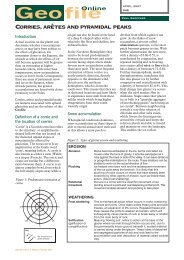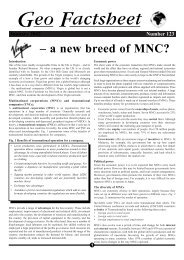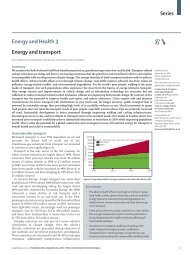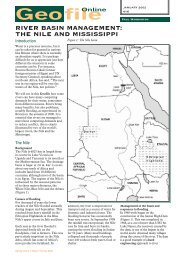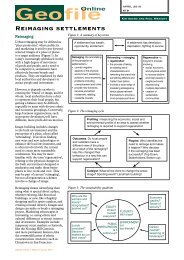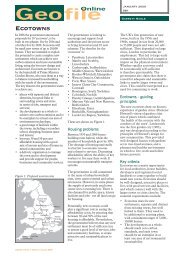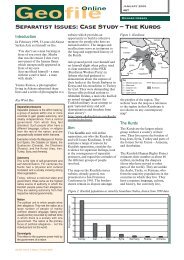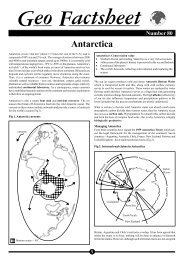25 Energy flow- Rainforests.pdf - Richmond School District No. 38
25 Energy flow- Rainforests.pdf - Richmond School District No. 38
25 Energy flow- Rainforests.pdf - Richmond School District No. 38
You also want an ePaper? Increase the reach of your titles
YUMPU automatically turns print PDFs into web optimized ePapers that Google loves.
Geo Factsheet<br />
September 1997 Number <strong>25</strong><br />
<strong>Energy</strong> Flow and Nutrient Cycling in Tropical <strong>Rainforests</strong><br />
Tropical Rain Forests (TRF) develop in areas which experience a combination of high rainfall and high temperatures with little monthly<br />
variation in average temperatures. For example, the minimum mean temperature of the coldest month may be as high as 18 o C, the annual<br />
temperature range will not exceed 5 o C and annual rainfall will exceed 1200mm.<br />
Fig 1. The distribution of tropical rainforests<br />
There are three main<br />
blocks of TRF:<br />
1. South and<br />
Central American<br />
2. Africa<br />
3. Indo-Malaysia<br />
<strong>No</strong>rth<br />
America<br />
USA<br />
Central<br />
America<br />
South<br />
America<br />
Tropical<br />
Rainforest<br />
Africa<br />
USSR<br />
India<br />
China<br />
Australia<br />
<strong>Energy</strong> <strong>flow</strong><br />
All tropical areas receive high levels of insolation.<br />
However, if forests generate their own cloud cover<br />
(through massive evapotranspiration) a large<br />
proportion of the incident radiation will be<br />
reflected and therefore total insolation may be<br />
less than in a non-forested area.<br />
In the tropics the amount of incoming radiation<br />
exceeds that which is re-radiated as longwave<br />
radiation i.e. the tropics are a net absorber of<br />
solar energy. This ‘energy surplus’ gives rise to<br />
global circulation patterns and the Inter Tropical<br />
Convergence Zone (ITCZ).<br />
The rainforest vegetation, which is classically<br />
described as being made up of 5 above-ground<br />
layers or strata is very efficient at absorbing<br />
incoming radiation.<br />
Light which manages to penetrate the oftenclosed<br />
canopy is usually absorbed by the smaller<br />
trees, epiphytes, climbers, tree ferns and giant<br />
herbs or saplings on the forest floor. Thus,<br />
incoming solar radiation is effectively converted<br />
to chemical energy in the process of<br />
photosynthesis. Gross Primary Productivity<br />
(GPP) - the total amount of organic matter fixed<br />
during photosynthesis (kg/m 2 /year) is extremely<br />
high in the TRF. This is a direct consequence of<br />
the high temperatures, high rainfall, huge amounts<br />
of photosynthetically active material and<br />
extremely rapid rate of nutrient recycling. Plants,<br />
like every other organism, use some of the<br />
chemical energy fixed during photosynthesis for<br />
their own energy needs i.e. they respire. The<br />
remainder is known as Net Primary Productivity.<br />
NPP = GPP - R<br />
Net<br />
Primary<br />
Productivity<br />
= Gross<br />
Primary<br />
Products<br />
1<br />
- Respiration<br />
Both NPP and biomass are high in the TRF<br />
(Table 1)<br />
Table 1. Net annual primary production<br />
and biomass<br />
Ecosystem<br />
Tropical<br />
Rainforest<br />
Temperate<br />
deciduous<br />
forest<br />
Boreal forest<br />
Desert<br />
Mean NPP<br />
per unit<br />
area g/m 2<br />
2200<br />
1200<br />
800<br />
90<br />
Mean<br />
Biomass per<br />
unit area<br />
kg/m 2<br />
45<br />
30<br />
20<br />
0.7
<strong>Energy</strong> Flow and Nutrient Recycling in Tropical <strong>Rainforests</strong><br />
Geo Factsheet<br />
<strong>No</strong>te: GPP is extremely high in TRF but R is<br />
also high because of the huge plant biomass<br />
which the photosynthesising tissues have to<br />
support. Despite this, NPP is still greater than<br />
in almost all other ecosystems on earth ( algal<br />
beds and reefs are commonly greater).<br />
Primary consumers (herbivores) gain their energy<br />
by eating the primary producers (the plants).<br />
Since primary production is high in the TRF, the<br />
numbers and biomass (dry weight per unit area<br />
e.g. mg/m 2 ) of primary, secondary and tertiary<br />
consumers which this primary production<br />
supports, is also high.<br />
Tropical Rain Forests contain more species of<br />
animals than any other ecosystem on earth. Food<br />
chains and webs are complex, but as in all other<br />
ecosystems, animals gain their energy by<br />
consuming plants (herbivores) or other animals<br />
(carnivores) or both (omnivores). This transfer<br />
of energy is not efficient. When an ant eats a leaf<br />
it gains only a fraction of the energy which was<br />
contained in the leaf. This is due to:<br />
1. The ant not eating all the leaf<br />
2. The ant immediately using some energy<br />
through respiration as it eats the leaf<br />
3. The ant losing some of the energy contained<br />
in the leaf because it couldn’t digest the leaf<br />
- the undigested material is passed out of the<br />
ant as faeces<br />
These three types of energy loss - through not<br />
all of the food source being eaten, through<br />
respiration and through faeces - occur at all<br />
subsequent stages of the food chain. It is precisely<br />
because of this energy loss that the number and<br />
biomass of organisms at each feeding level<br />
(trophic level) decrease.<br />
To summarise, energy <strong>flow</strong>s through the TRF<br />
ecosystem (Fig 2)<br />
Fig 2. <strong>Energy</strong> Flow<br />
SUN<br />
<strong>Energy</strong> lost as heat during respiration<br />
Primary<br />
Producer<br />
1% of chemical<br />
energy transferred<br />
when eaten<br />
Primary<br />
Consumer<br />
1% of chemical<br />
energy transferred<br />
when eaten<br />
Secondary<br />
Consumer<br />
1% of chemical<br />
energy transferred<br />
when eaten<br />
Tertiary<br />
Consumer<br />
<strong>Energy</strong> lost as heat during respiration<br />
Decomposers<br />
Chemical energy lost in faeces<br />
Nutrient inputs and outputs<br />
Nutrients dissolved in rainwater represent an<br />
important input. Most rainfall contains ions such<br />
as nitrate (NO 3-<br />
) but, in any case, rainfall<br />
penetrating the canopy may leach nutrients out<br />
of the foliage or out of algae and will wash insect<br />
deposits (frass) off leaves. It is also clear that,<br />
whilst some nutrients are removed from the<br />
foliage by rainfall, other nutrients are actually<br />
absorbed from the rainfall by leaves, aerial roots<br />
and epiphytes. The result is that the<br />
concentration of nutrients in the throughfall<br />
(water reaching the soil) is often very different<br />
from that of the original rainfall.<br />
Decomposition of leaves, twigs, fruits, <strong>flow</strong>ers,<br />
dead animals and faeces releases minerals into<br />
the soil. Such minerals may be leached or<br />
absorbed by plant roots. The top 20-30<br />
centimetres of soil contains a dense network of<br />
fine roots which are capable of absorbing soluble<br />
nutrients extremly rapidly. Some tree species<br />
have very deep tap roots which recapture leached<br />
nutrients which would otherwise be effectively<br />
lost to the system. The pattern of nutrient input<br />
and output is summarised in Fig 3.<br />
Nutrient cycles<br />
Nutrients - inorganic substances such as nitrogen<br />
(N), phosphorus (P), potassium (K) and calcium<br />
(Ca) - are found in the soil and litter. Nutrients<br />
are cycled between these three stores. Usually<br />
this is shown in the form of a <strong>flow</strong> diagram,<br />
where the size of the circles represents the<br />
amount of nutrients in a store and the width of<br />
the arrows between the circles represents the<br />
importance of each type of nutrient transfer.<br />
The common perception is that most nutrients<br />
of a TRF are in the biomass, with the least<br />
biomass in the soil. This is an oversimplification<br />
2<br />
but nevertheless this is the pattern which all<br />
candidates must be able to describe and explain<br />
(Fig 4 overleaf).<br />
Exam Exam Hint Hint -- Candidates Candidates frequently frequently show show<br />
great great confusion confusion about about tropical tropical soils. soils. Some Some<br />
clearly clearly believe believe that that they they are are all all very very deep deep<br />
and and nutrient nutrient rich, rich, others others indicate indicate that that all all<br />
TRF TRF soils soils are are shallow shallow and and nutrient nutrient<br />
deficient. deficient. The The truth truth is is more more complex complex and and<br />
good good candidates candidates will will show show the the examiners examiners<br />
that that they they appreciate appreciate this this. (see Fig 5).<br />
Figure 5 shows the distribution of inorganic<br />
nutrients above and below ground in three TRF<br />
areas. Table 2 summarises the principles<br />
underlying nutrient cycling and their implications<br />
for sustainable management.
<strong>Energy</strong> Flow and Nutrient Recycling in Tropical <strong>Rainforests</strong><br />
Geo Factsheet<br />
Fig 3. Nutrient cycling in rainforests<br />
Nitrogen fixation by<br />
organisms living in<br />
canopy<br />
Deposition of dust<br />
and aerosols<br />
Rain input - e.g. from burning elsewhere<br />
Loss of nutrients<br />
from soil and litter<br />
by dentrification<br />
Throughfall<br />
N P K Ca Mg<br />
Gaseous loss<br />
(mineralisation)<br />
in fires<br />
Leaching<br />
of canopy<br />
Fine litterfall (leaves)<br />
(N, P, K, Ca, Mg)<br />
Large litterfall (branches,<br />
epiphytes, trees)<br />
Stem<strong>flow</strong><br />
Decomposition<br />
Loss through<br />
run-off and<br />
erosion<br />
Leaching<br />
Weathering<br />
Uptake of nutrients in<br />
solution<br />
Weathering<br />
Stream<strong>flow</strong><br />
Rock<br />
Fig 4. Nutrient stores and cycles - This is the classical picture presented in almost all textbooks and examined on almost all syllabuses. However,<br />
nutrient assays (measurements) in many different areas of TRF suggest that this distribution is not always, or even often correct. The overall picture is<br />
more complex (see also Fig 5).<br />
Soil = Smaller store of nutrients<br />
than Biomass because:<br />
1. Rapid absorption by<br />
dense network of shallow<br />
roots. Most trees have<br />
symbiotic fungi which<br />
accelerate the uptake of<br />
nutrients such as<br />
phosphorus<br />
2. High rainfall encourages<br />
leaching<br />
3. High rates of transpiration<br />
mean that water, hence<br />
nutrients are rapidly<br />
reabsorbed to replace that<br />
lost through the stomata<br />
Uptake in<br />
solution by<br />
root hairs<br />
S<br />
B<br />
Decomposition by soil<br />
invertebrates eg. termites<br />
and earthworms and by<br />
bacteria and fungi<br />
Biomass = Large store of nutrients because high<br />
temperatures; high rainfall, long growing season<br />
and rapid absorption from soil means that the<br />
rate of photosynthesis, hence productivity is high.<br />
1. Leaves, fruits, <strong>flow</strong>ers, twigs falling to the forest floor<br />
2. Leaching of foliage and frass washings<br />
Litter =Small store of nutrients because<br />
high temperatures and moisture levels<br />
result in very fast decomposition by<br />
soil fauna. Nutrients are therefore<br />
rapidly transferred from Litter to Soil.<br />
L<br />
3
<strong>Energy</strong> Flow and Nutrient Recycling in Tropical <strong>Rainforests</strong><br />
Geo Factsheet<br />
Fig 5. The distribution of inorganic nutrients above and below ground in three TRF areas<br />
100<br />
Brazil (473 t/ha)<br />
(Lowland rain forest)<br />
N P<br />
140<br />
K Ca<br />
530<br />
Mg<br />
7540<br />
%<br />
550 290<br />
Ghana (287 t/ha)<br />
(Lowland rain forest)<br />
N P<br />
170<br />
K Ca<br />
5790<br />
Mg<br />
6870 1590 740<br />
New Guinea (350 t/ha)<br />
(Lower Montane rain forest)<br />
N P<br />
69<br />
K Ca<br />
5510<br />
Mg<br />
20200 1290 957<br />
kg/ha<br />
Exam Hint - The strongest candidates<br />
link theory to practice. In other words<br />
they show a clear understanding of how<br />
rainforest management should be<br />
influenced by our understanding of their<br />
ecology (see Table 2).<br />
80<br />
60<br />
40<br />
20<br />
0<br />
1234<br />
1234 1234<br />
1234<br />
1234 12345<br />
123412345<br />
1234<br />
1234 12345<br />
1234<br />
12345<br />
1234<br />
1234<br />
12345<br />
1234<br />
1234<br />
12345 1234 123412345<br />
12345 1234<br />
1234 12345<br />
1234<br />
1234<br />
1234 12345<br />
1234 12345<br />
1234<br />
12345<br />
1234<br />
1234<br />
12345<br />
1234512341234<br />
1234<br />
12345<br />
1234 123412345<br />
1234 12345<br />
1234 12345<br />
1234 12345 1234<br />
1234<br />
12345<br />
1234<br />
1234<br />
12345<br />
12345 1234<br />
1234 1234<br />
1234<br />
1234<br />
123412345<br />
12345<br />
1234<br />
1234 12345<br />
1234<br />
12345<br />
1234<br />
1234<br />
1234<br />
1234<br />
1234<br />
1234<br />
1234<br />
1234<br />
1234 12345<br />
12345 1234<br />
123451234<br />
12345<br />
1234<br />
12345 123451234<br />
1234<br />
1234 12345 123451234<br />
1234<br />
123451234<br />
12345<br />
1234<br />
1234<br />
1234 12345 123451234<br />
1234<br />
123451234<br />
12345<br />
1234<br />
1234<br />
1234 12345 12345<br />
1234<br />
1234<br />
12345<br />
1234<br />
1234 12345 12345 1234<br />
1234<br />
12345 1234<br />
12345<br />
1234<br />
1234<br />
12345<br />
1234<br />
1234<br />
12345<br />
12345<br />
12345<br />
12345<br />
12345<br />
123451234<br />
1234<br />
12345<br />
123451234<br />
1234<br />
12345<br />
12345 1234<br />
1234<br />
123412345<br />
1234<br />
12345<br />
12345 1234<br />
1234 12345<br />
123412345<br />
1234<br />
12345<br />
123412345<br />
1234<br />
12345<br />
1234<br />
1234 12345<br />
1234<br />
1234512345<br />
12345<br />
1234<br />
1234<br />
123451234<br />
1234<br />
12345<br />
12345<br />
Key<br />
12345<br />
12345<br />
12345<br />
12345<br />
12345<br />
12345<br />
12345<br />
12345<br />
12345<br />
12345<br />
12345<br />
12345<br />
12345<br />
j<br />
j<br />
Aerial<br />
biomass<br />
Forest floor<br />
Roots<br />
20<br />
40<br />
12345<br />
1234<br />
j<br />
Soil<br />
(0-0.3m)<br />
60<br />
80<br />
100<br />
All three areas show that many nutrients are in the above-ground biomass and that usually, very few nutrients are found as litter on the forest<br />
floor. However, it is also apparent that the nutrient content of TRF soils varies dramatically. A large proportion of nitrogen (N) is often found in<br />
the soil whilst nutrients such as potassium (K) mostly exist in the above-ground biomass. In young, shallow soils the weathering parent material<br />
will add to the nutrient content of the soil and nutrient concentrations may therefore be high. In contrast, old, deep (e.g. 20-30m) soils in parts of<br />
Amazonia effectively receive no new nutrients from weathering of the original parent material. Nutrient concentrations in these soils may be very<br />
low.<br />
Table 2. Implications for TRF management<br />
Feature Implication Mangement Technique<br />
A large proportion of nutrients are found in the<br />
above-ground biomass. Many of these nutrients<br />
are in the leaves, twigs and small branches.<br />
<strong>Rainforests</strong> intercept a very high proportion of<br />
rainfall and, in all areas, total rainfall is high and<br />
is often intense.<br />
Deep rainforest soils may recieve virtually no<br />
input of nutrients from weathering bedrock.<br />
Nutrient input is dependant upon decomposition<br />
of vegetation, atmospheric inputs via rainfall and<br />
deep nutrient capture by the long tap roots of<br />
dominant trees.<br />
Most roots, suckers, decomposition and seed<br />
germination occur close to the soil surface.<br />
Deforestation and removal of whole trees will<br />
permanently remove nutrients, breaking the<br />
nutrient cycles.<br />
Deforestation will dramatically reduce<br />
interception. Consequently the impact velocity<br />
and therefore erosivity of rainfall will increase.<br />
Nutrient leaching will dramatically increase.<br />
Conversion of rainforest to arable crops<br />
completely disrupts nutrient cycles. Continuous<br />
cultivation of arable crops is impossible without<br />
sustained use of artificial fertilisers and careful<br />
rotation.<br />
Soil compaction caused by heavy machinery<br />
during logging may kill roots, rapidly reducing<br />
nutrient absorption and prevent regrowth.<br />
Selective felling, where some of the trees in an<br />
area are left behind will help to maintain the<br />
nutrient cycles. Debranching on site, leaving the<br />
leaves, twigs and branches behind, will effectively<br />
allow the return of many nutrients to the soil.<br />
Low intensity, selective logging will help to<br />
reduce these impacts.<br />
Agroforestry (the subject of a future Factsheet)<br />
- where trees and crops are grown together -<br />
may be more sustainable.<br />
Low mechanisation harvesting techniques may<br />
be more appropriate.<br />
Acknowledgements; This Geo Factsheet was researched and written by Kevin Byrne.<br />
Geopress Factsheets may be copied free of charge by teaching staff or students, provided that their school is a registered subscriber.<br />
<strong>No</strong> part of these Factsheets may be reproduced, stored in a retrieval system, or transmitted, in any other form or by any other means, without the prior permission of the publisher.<br />
ISSN 1351-5136<br />
4



